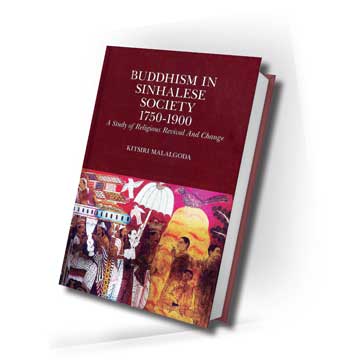Thursday Dec 25, 2025
Thursday Dec 25, 2025
Saturday, 8 June 2024 00:00 - - {{hitsCtrl.values.hits}}
 By Prabhath Sirisena
By Prabhath Sirisena
Sri Lankan Buddhists are spoiled for choice these days. Depending on where your faith lies and what tugs at your heart, it seems you can choose the flavour of Theravada Buddhism that suits you best: from the traditional temple Buddhism of the great sects of Kandy to the radical orthopraxy of ascetic Buddhism in remote forest monasteries, and from the devotional Buddhism of Mahamevna to the contrarian, eclectic mix of teachings at Umandawa, the variety can be dazzling—so much so that one could be excused for thinking that this lack of homogeneity is a sign of decay.
Kitsiri Malalgoda, in his classic study Buddhism in Sinhalese Society 1750–1900 shows us that there is nothing new with these ebbs and flows in the sāsana. Buddhism has always been plural in the island. It has also been resilient, perhaps because of that very plurality. Whenever all hope seemed to have been lost—as in the low points during the colonial period Malalgoda talks about in great detail—the religion has managed to sprout back into life. This, I think, is the biggest lesson for us in the present day from Malalgoda’s book that deals with our recent past: we are not just creators, but heirs, of multiple Buddhisms.
Malalgoda tells this story in two parts. The first part begins with an exploration of the form of Buddhism one could witness in the last decades of the Kandyan kingdom, prior to its conquest by the British in 1815. Here we find the unique quasi-monastic character of gaṇinnānse—a religious specialist that is not a layman but not quite a monk, and also not found before or since in our history. The emergence of the Silvat Samāgama in this period, led by the charismatic elder Venerable Saraṇaṃkara, initiated a series of monastic reforms that reverberates to this day. Ironically, the Dutch colonial conquestors also played a vital role in that reform, facilitating the introduction of higher ordination (upasampadā) from historical Siyam (Thailand).
The Sangha, however, does not remain a unitary institution: there is conflict within the Siyam sect, and between the classes, resulting in more sects (and sub-sects!) that reject Siyam authority. There are even monks plotting to assassinate the king, a habit that the post-independence Sangha cannot claim to have entirely rid itself of, if the events in 1950s were an indication. In fact, the political machinations of monastic institutions and the religious meddlings of political operators is a key theme that runs through the study.
The colourful and detailed story of Sinhala Buddhism related by Malalgoda takes a new turn in the second part of the book, with the arrival of so-called Protestant Buddhism. In this phase in the late 19th century, we find Buddhists learning new tricks from their colonial masters, sometimes beating them at their own game, but also seemingly changing Buddhism in the process. An organized, rational, and intellectual Buddhism begins to take root, with Anagarika Dharmapala and the theosophists at its forefront, using institutions such as schools and the press to proselytize novel interpretations and practices that can better withstand the challenges of its day. By this time, Kandy had given way to Colombo as the Buddhist epicentre of the country. In many ways, the forms of Buddhism we see today have all been heavily influenced by the reforms Malalgoda discusses in these chapters.
Reading about this recent history is a humbling experience, in that it questions our ideas of decline and revival. As we get to know the events that unfolded during these difficult times for Buddhism in the country, we develop a deeper appreciation for the difficulty in identifying what is progress or regress while we are engaged in living through that process. Well-intentioned actions towards the betterment of the sāsana do not necessarily lead to beneficial results, simply because it is humanly impossible to have an objective perspective, especially into the future. Alternatively, blessings may come in forms we do not recognize, and what is revealed by the Buddhist populace today might be the very thing that ensures the teachings survive for future generations. This is a lesson we cannot afford to ignore, and one that Malalgoda imparts in exquisite detail.
Buddhism in Sinhalese Society has its origins in Malalgoda’s doctoral studies at Oxford in the late 1960s. First published in 1976 by the University of California Press, over the years, it has gained a reputation as one of the most comprehensive and meticulous works on Sri Lankan Buddhism. Getting a copy of it, however, has not been easy as of late. There are international copies available in digital format for astronomical fees, but thankfully, Tambapanni Academic Publishers have now released a Sri Lankan paperback edition at a very reasonable price. This is a book that deserves a place on the shelf of anyone interested in Sri Lankan Buddhism.
(The writer is a visiting researcher at the Leiden University Institute for Area Studies.)